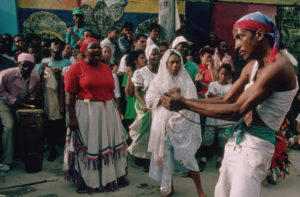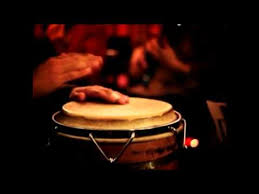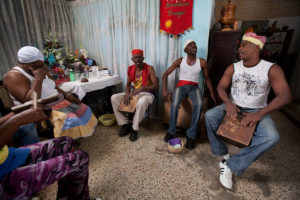EL BEMBÉ, THE MAIN CEREMONY OF THE AFRO-CUBAN FOLK RELIGION “SANTERIA” PHOTOS/VIDEOS.
Mainly in Cuba and Puerto Rico, the main ceremony of the Santeria is the “Bembé” or “Toque de Santos”, as it is also called. The rite both begins and ends with a prayer to Elegguá, known in Cuba and Puerto Rico as the orisha (deity) who is the “owner” of roads and paths. All ceremonies and rituals in Santeria must first have Elegua’s approval before progressing.
The ceremony resounds to the sound of the “atabales” (tambourine played at parties). The “batás” drums beat incessantly. The “güiros” provide further background for the choir of voices which raises its chant to the dwelling place of the “orishas”. The faces of the worshipers seem transformed by the esoteric summons to possession. The gong of the atabales sounds louder. The odor of the jungle invades the place of worship. The chant grows louder on the Lucumí tongue:
“Ilá mi ilé oro…
“Ilá mi ilé oro…
“Iyá mi.
“Iyá mi, Saramawooooo
“Iyá mi ilé oro…
https://youtu.be/-nJsvYD133I
Press ^ Here
BEMBE CEREMONY IN CUBA
The sweating bodies shake in a frenzy with each beat of the drums. Legs, shoulders, and bodies tremble as if reacting to an electric shock. A strange feeling of well-being invades every heart; it is visible in the emotion-twisted faces and the bleary eyes of the dancers. Their temples pound. At last –a body becomes possessed. A woman falls to the floor, her body jumping savagely, while from hundreds of throats the cry resounds.
“Gecua, Gey…”
This signifies the arrival of the saint. He has entered the body of a believer. He is among them and preparing to speak with the tongue of his “horse” and to dance in the physical form of his “instrument”.
If you were to ask the santero what happening, he would tell you that the saint has displaced the soul of the worshipper and occupied his body, to be able to communicate with men here on earth. The saint, he would tell you, is of spirit and space and lacks the physical attributes of a human…
https://youtu.be/te8zxxScCQc
Presione ^ Aqui
BEMBE CEREMONY EN CUBA
Now the saint dances frenetically to the beat of the drums which incite him to further frenzied motion.
The Bembé has entered its moments of climax. Now everything is jungle –primitive, vigorous, fringed with omens and deep fears…
Before “departing”, the god will speak to the men, will advise them on ways to preserve their health, to avoid “troubles”, to help others find employment. The god will also ask his due; he will demand a feat; he will even threaten his naughty “children”.
And when the saint has left the body of the “aleyo”, faith and belief will be stronger, and the body of the possessed will be sore in the aftermath of its frenzied contortions.
These are the origins of the diverse African belief still found in Cuba. They are everywhere on the island. A traces of Africanism remains in every Cuban, giving rise to a popular tune which goes:
“He who does not wear yellow (the color of Ochún).
“Covers himself with blue cloth (the color of Yemayá).
“Or red (belonging to Changó)”.
That is also the thought behind the proverb: “There are those who remember Saint Barbara when it thunders”.
For the same reason, a politician once noted that “in Cuba, the man who does not have an ancestor from the Congo has one from Carabalí…”
EL BEMBE, LA CEREMONIA PRINCIPAL DE LA SANTERIA AFRO-CUBANA. FOTOS Y VIDEOS
Principalmente en Cuba y Puerto Rico, la ceremonia principal conocida como Santería es el Bembé o “Toque de Santos”, como también se le llama. El rito comienza y termina con una oración a Elegguá, conocido en Cuba y Puerto Rico como el orisha (deidad) que es el “dueño” de caminos y senderos. Todas las ceremonias y rituales en la santería deben contar primero con la aprobación de Elegua antes de avanzar.
La ceremonia resuena al son de los “atabales” (pandereta que se toca en las fiestas). Los tambores batás suenan incesantemente. Los “güiros” proporcionan un fondo adicional para el coro de voces que eleva su canto a la morada de los “orishas”. Los rostros de los adoradores parecen transformados por la llamada esotérica a la posesión. El gong de los atabales suena más fuerte. El olor de la selva invade el lugar de culto. El cántico se hace más fuerte en la lengua lucumí:
“Ilá mi ilé oro …
“Ilá mi ilé oro …
“Iyá mi.
“Iyá mi, Saramawooooo
“Iyá mi ilé oro …
https://youtu.be/Kkot9cmhpkQ
Presione ^ Aqui
EL BEMBE CEREMONIA EN CUBA
Los cuerpos sudorosos se sacuden frenéticamente con cada golpe de los tambores. Las piernas, los hombros y el cuerpo tiemblan como si reaccionaran a una descarga eléctrica. Una extraña sensación de bienestar invade todos los corazones; es visible en los rostros emocionados y en los ojos nublados de los bailarines. Sus sienes palpitan. Por fin, un cuerpo se vuelve poseído. Una mujer cae al suelo, su cuerpo salta salvajemente, mientras de cientos de gargantas resuena el grito.
“Gecua, Gey …”
Esto significa la llegada del santo. Ha entrado en el cuerpo de un creyente. Él está entre ellos y se prepara para hablar con la lengua de su “caballo” y bailar en la forma física de su “instrumento”.
Si le preguntaras al santero qué está pasando, te diría que el santo ha desplazado el alma del adorador y ocupado su cuerpo, para poder comunicarse con los hombres aquí en la tierra. El santo, les diría, es de espíritu y espacio y carece de los atributos físicos de un humano …
Ahora el santo baila frenéticamente al ritmo de los tambores que lo incitan a un movimiento más frenético.
https://youtu.be/NgCLQZXA9WA
Presione ^ Aqui
BEMBE CEREMONIA EN CUBA
El Bembé ha entrado en sus momentos de clímax. Ahora todo es jungla, primitivo, vigoroso, bordeado de presagios y profundos miedos …
Antes de “partir”, el dios hablará con los hombres, les aconsejará sobre las formas de preservar su salud, para evitar “problemas”, para ayudar a otros a encontrar empleo. El dios también pedirá lo que le corresponde; exigirá una hazaña; incluso amenazará a sus traviesos “niños”.
Y cuando el santo haya abandonado el cuerpo del “aleyo”, la fe y la fe serán más fuertes, y el cuerpo del poseído estará adolorido por las secuelas de sus frenéticas contorsiones.
Estos son los orígenes de las diversas creencias africanas que aún se encuentran en Cuba. Están por todas partes en la isla. Un rastro de africanismo permanece en cada cubano, dando lugar a una melodía popular que dice:
“El que no viste de amarillo (el color de Ochún).
“Se cubre con tela azul (el color de Yemayá).
“O rojo (perteneciente a Changó)”.
Ese es también el pensamiento detrás del proverbio: “Hay quienes recuerdan a Santa Bárbara cuando truena”.
Por lo mismo, un político señaló una vez que “en Cuba, el hombre que no tiene antepasado del Congo tiene uno de Carabalí …”
Agencies/ Felipe Elosegui/ Ceremonias A-C/ Extractos/ Excerpts/ Internet Photos/ Arnoldo Varona/ www.TheCubanHistory.com
THE CUBAN HISTORY, HOLLYWOOD.











